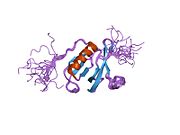CADPS
| CADPS | |||||||||||||||||||||||||||||||||||||||||||||||||||
|---|---|---|---|---|---|---|---|---|---|---|---|---|---|---|---|---|---|---|---|---|---|---|---|---|---|---|---|---|---|---|---|---|---|---|---|---|---|---|---|---|---|---|---|---|---|---|---|---|---|---|---|
 | |||||||||||||||||||||||||||||||||||||||||||||||||||
| |||||||||||||||||||||||||||||||||||||||||||||||||||
| Identifiers | |||||||||||||||||||||||||||||||||||||||||||||||||||
| Aliases | CADPS, CADPS1, CAPS, CAPS1, UNC-31, Ca2+ dependent secretion activator, calcium dependent secretion activator | ||||||||||||||||||||||||||||||||||||||||||||||||||
| External IDs | OMIM: 604667; MGI: 1350922; HomoloGene: 2755; GeneCards: CADPS; OMA:CADPS - orthologs | ||||||||||||||||||||||||||||||||||||||||||||||||||
| |||||||||||||||||||||||||||||||||||||||||||||||||||
| |||||||||||||||||||||||||||||||||||||||||||||||||||
| |||||||||||||||||||||||||||||||||||||||||||||||||||
| |||||||||||||||||||||||||||||||||||||||||||||||||||
| |||||||||||||||||||||||||||||||||||||||||||||||||||
| Wikidata | |||||||||||||||||||||||||||||||||||||||||||||||||||
| |||||||||||||||||||||||||||||||||||||||||||||||||||
Calcium-dependent secretion activator 1 is a protein that in humans is encoded by the CADPS gene.[5][6]
CADPS encodes a novel neural/endocrine-specific cytosolic and peripheral membrane protein required for the Ca2+-regulated exocytosis of secretory vesicles. CADPS acts at a stage in exocytosis that follows ATP-dependent priming, which involves the essential synthesis of phosphatidylinositol 4,5-bisphosphate (PtdIns(4,5)P2). Alternative splicing has been observed at this locus and three variants, encoding distinct isoforms, are described.[6]
References
- ^ a b c GRCh38: Ensembl release 89: ENSG00000163618 – Ensembl, May 2017
- ^ a b c GRCm38: Ensembl release 89: ENSMUSG00000054423 – Ensembl, May 2017
- ^ "Human PubMed Reference:". National Center for Biotechnology Information, U.S. National Library of Medicine.
- ^ "Mouse PubMed Reference:". National Center for Biotechnology Information, U.S. National Library of Medicine.
- ^ Walent JH, Porter BW, Martin TF (Oct 1992). "A novel 145 kd brain cytosolic protein reconstitutes Ca(2+)-regulated secretion in permeable neuroendocrine cells". Cell. 70 (5): 765–75. doi:10.1016/0092-8674(92)90310-9. PMID 1516133. S2CID 29122392.
- ^ a b "Entrez Gene: CADPS Ca2+-dependent secretion activator".
External links
- Human CADPS genome location and CADPS gene details page in the UCSC Genome Browser.
- Human CAPS genome location and CAPS gene details page in the UCSC Genome Browser.
Further reading
- Nakajima D, Okazaki N, Yamakawa H, et al. (2003). "Construction of expression-ready cDNA clones for KIAA genes: manual curation of 330 KIAA cDNA clones". DNA Res. 9 (3): 99–106. doi:10.1093/dnares/9.3.99. PMID 12168954.
- Nishizaki T, Walent JH, Kowalchyk JA, Martin TF (1992). "A key role for a 145-kDa cytosolic protein in the stimulation of Ca(2+)-dependent secretion by protein kinase C." J. Biol. Chem. 267 (33): 23972–81. doi:10.1016/S0021-9258(18)35932-5. PMID 1429734.
- Ann K, Kowalchyk JA, Loyet KM, Martin TF (1997). "Novel Ca2+-binding protein (CAPS) related to UNC-31 required for Ca2+-activated exocytosis". J. Biol. Chem. 272 (32): 19637–40. doi:10.1074/jbc.272.32.19637. PMID 9289490.
- Loyet KM, Kowalchyk JA, Chaudhary A, et al. (1998). "Specific binding of phosphatidylinositol 4,5-bisphosphate to calcium-dependent activator protein for secretion (CAPS), a potential phosphoinositide effector protein for regulated exocytosis". J. Biol. Chem. 273 (14): 8337–43. doi:10.1074/jbc.273.14.8337. PMID 9525942.
- Berwin B, Floor E, Martin TF (1998). "CAPS (mammalian UNC-31) protein localizes to membranes involved in dense-core vesicle exocytosis". Neuron. 21 (1): 137–45. doi:10.1016/S0896-6273(00)80521-8. PMID 9697858.
- Hirosawa M, Nagase T, Ishikawa K, et al. (2000). "Characterization of cDNA clones selected by the GeneMark analysis from size-fractionated cDNA libraries from human brain". DNA Res. 6 (5): 329–36. doi:10.1093/dnares/6.5.329. PMID 10574461.
- Nakayama M, Kikuno R, Ohara O (2003). "Protein-protein interactions between large proteins: two-hybrid screening using a functionally classified library composed of long cDNAs". Genome Res. 12 (11): 1773–84. doi:10.1101/gr.406902. PMC 187542. PMID 12421765.
- Strausberg RL, Feingold EA, Grouse LH, et al. (2003). "Generation and initial analysis of more than 15,000 full-length human and mouse cDNA sequences". Proc. Natl. Acad. Sci. U.S.A. 99 (26): 16899–903. Bibcode:2002PNAS...9916899M. doi:10.1073/pnas.242603899. PMC 139241. PMID 12477932.
- Cisternas FA, Vincent JB, Scherer SW, Ray PN (2003). "Cloning and characterization of human CADPS and CADPS2, new members of the Ca2+-dependent activator for secretion protein family". Genomics. 81 (3): 279–91. doi:10.1016/S0888-7543(02)00040-X. PMID 12659812.
- Speidel D, Varoqueaux F, Enk C, et al. (2004). "A family of Ca2+-dependent activator proteins for secretion: comparative analysis of structure, expression, localization, and function". J. Biol. Chem. 278 (52): 52802–9. doi:10.1074/jbc.M304727200. PMID 14530279.
- Ota T, Suzuki Y, Nishikawa T, et al. (2004). "Complete sequencing and characterization of 21,243 full-length human cDNAs". Nat. Genet. 36 (1): 40–5. doi:10.1038/ng1285. PMID 14702039.
- Gerhard DS, Wagner L, Feingold EA, et al. (2004). "The status, quality, and expansion of the NIH full-length cDNA project: the Mammalian Gene Collection (MGC)". Genome Res. 14 (10B): 2121–7. doi:10.1101/gr.2596504. PMC 528928. PMID 15489334.
- Binda AV, Kabbani N, Levenson R (2005). "Regulation of dense core vesicle release from PC12 cells by interaction between the D2 dopamine receptor and calcium-dependent activator protein for secretion (CAPS)". Biochem. Pharmacol. 69 (10): 1451–61. doi:10.1016/j.bcp.2005.02.015. PMID 15857609.
- v
- t
- e
-
 1wi1: Solution structure of the PH domain of human calcium-dependent activator protein for secretion (CAPS)
1wi1: Solution structure of the PH domain of human calcium-dependent activator protein for secretion (CAPS)
 | This article on a gene on human chromosome 3 is a stub. You can help Wikipedia by expanding it. |
- v
- t
- e


















